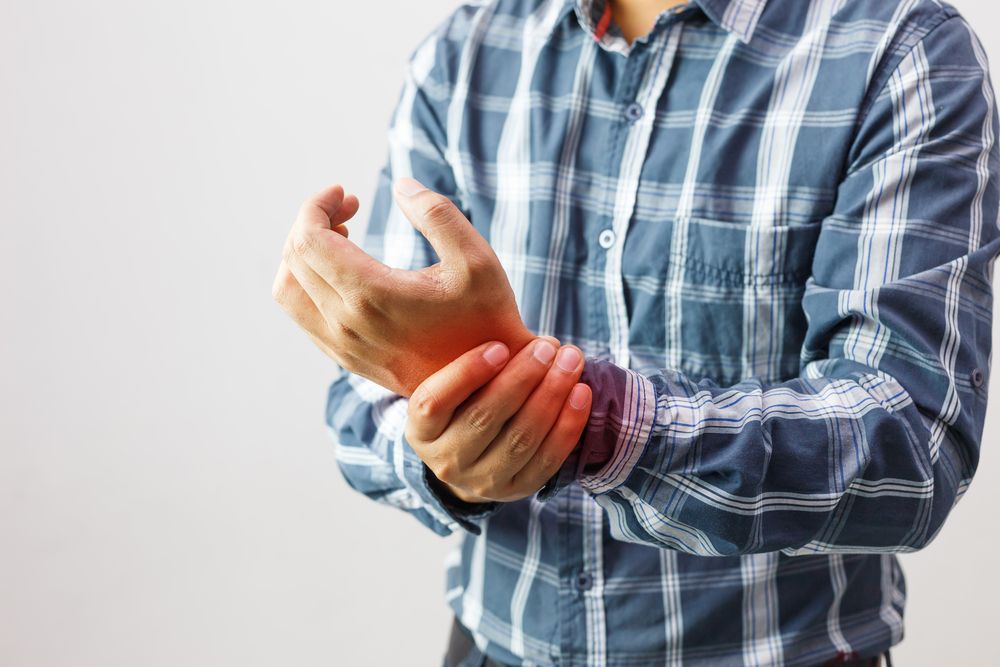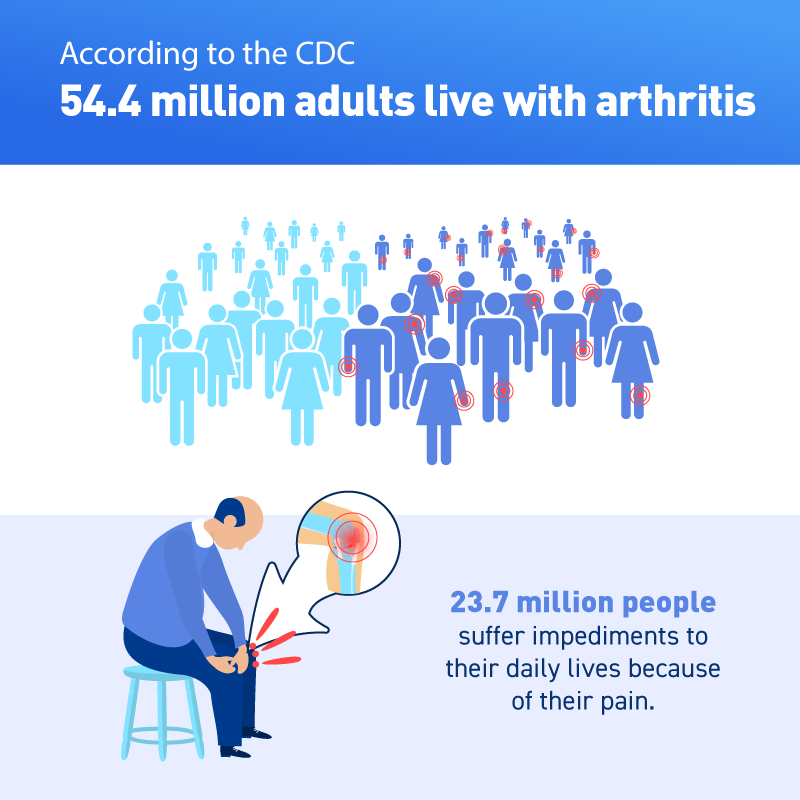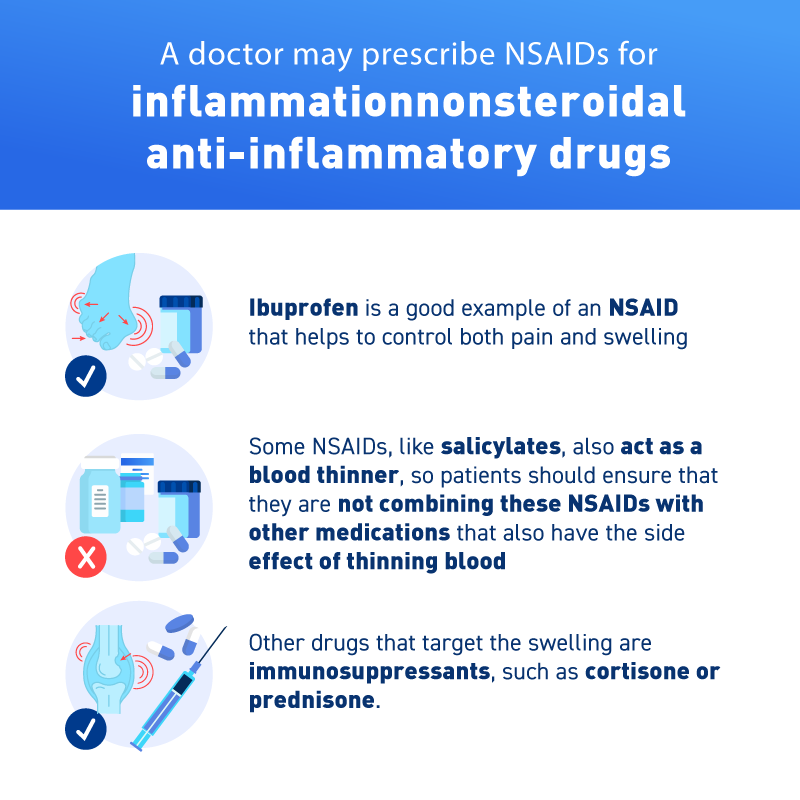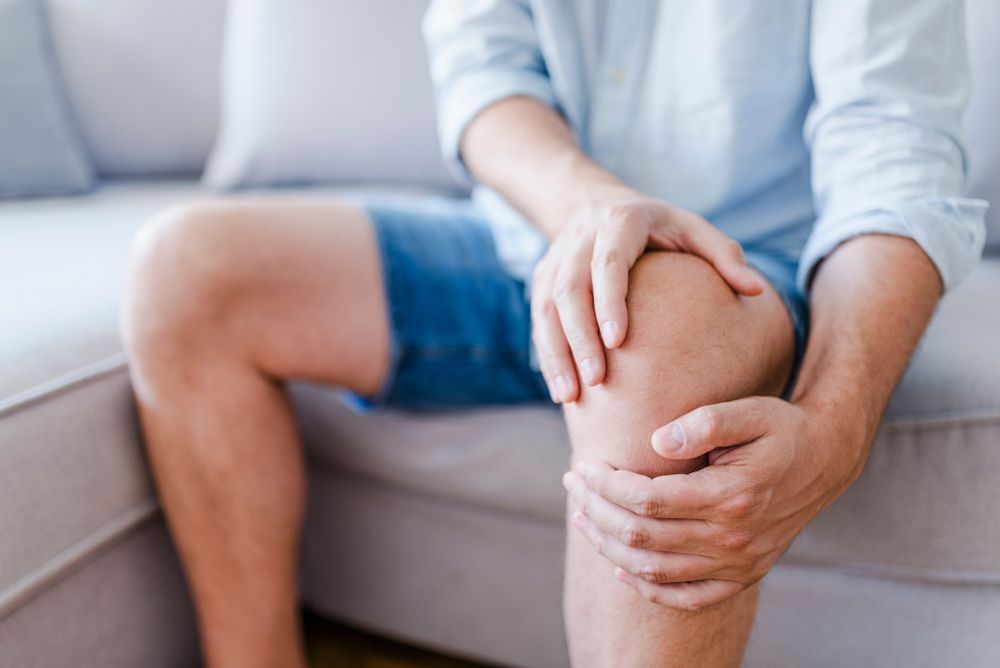Arthritis refers to a number of conditions where the connective tissue around joints becomes inflamed, usually as the result of aging, or wear and tear. (Learn More) Patients feel stiffness, pain, and a reduced range of motion in the affected areas, which can further lead to other problems. (Learn More)
Treatment for arthritis is usually in the form of painkillers and nonsteroidal anti-inflammatory drugs, along with creams and lotions to soothe the physical discomfort. (Learn More)
More experimental therapies include stimulating the nerves and subjecting the joints to microwave radiation, as a way of increasing blood flow to the swollen joints. (Learn More) Massage and light physical therapy round out the treatments for arthritis in 2022. (Learn More)
What Is Arthritis?
The simple definition of arthritis is that it is an inflammation of the joints, the intersections of bones in the body that constitutes the entire skeletal system. Arthritis can affect a single joint or multiple joints.
There are hundreds of different types of arthritis, each with its own causes and treatments. The most common ones are rheumatoid arthritis (RA) and osteoarthritis (OA).
Beyond the joints, arthritis also affects the tissues that surround the affected joints and other connective tissues.
In most cases, arthritis develops over a period of time, but it can also appear suddenly. Arthritis most commonly develops in adults over 65, but juvenile rheumatoid arthritis and juvenile idiopathic arthritis are both documented conditions. It typically occurs more often in women than men, and it is more common in people who are overweight.
Symptoms and Scope
Symptoms of arthritis include pain, stiffness, and swelling in and around the joints. Movement in the affected parts of the body can be limited, and many people experience a reddish tint to their skin where the joints are suffering. Patients usually feel the most pain in the morning.
Rheumatoid arthritis and lupus (one of the forms of arthritis) can strike multiple organs and cause problematic symptoms across the body. As an example, patients with RA will experience inflammation of their immune system, leading to fatigue and loss of appetite. If the rheumatoid arthritis is not treated, patients will become anemic as a result of a drop in their red blood cells. They are at risk for permanent deformation of the impacted joints.
Arthritis is widespread. The Centers for Disease Control and Prevention writes that 54.4 million adults have been diagnosed with it, and 23.7 million people suffer impediments to their daily lives because of their pain.
Causes of Arthritis
To understand how arthritis develops, it is necessary to understand how the joints in the body are put together.
The first place to look is cartilage, a tense but flexible connective tissue in the joints. The job of cartilage is to protect the joints. When a person moves and puts stress on the joints, the cartilage absorbs the impact. Some forms of arthritis are caused by the amount of cartilage decreasing, either due to age, genetics (especially a family history of arthritis), lifestyle, or other factors.
In fact, normal wear and tear is a factor for osteoarthritis, which is why it is one of the most common forms of the condition. Infection or injury can also result in cartilage being broken down faster and exposing the joints to damage.
Rheumatoid arthritis, on the other hand, is an autoimmune disorder. It’s a condition where the body’s immune system turns on itself, attacking its own tissues. The target is synovium, a soft tissue in the joints that provides nourishment to the cartilage and lubrication to the joints.
Why this happens is not fully understood, but it is generally believed that people who have the condition have specific genetic markers that greatly increase the risk of it developing.
Treating Arthritis
Arthritis treatment seeks to reduce the amount of pain patients are in and to prevent the joints from incurring any further damage. Controlling pain can be as simple as using ice packs and heating pads to cool the affected areas. Other patients might need to reduce the pressure on their joints by using canes, walkers, or other mobility assistance devices.
One way a doctor will look to treat arthritis is to improve the patient’s joint function, which may cover a combination of methods. In addition to mobility devices and heating/cooling accessories, there may also be medication and mild physical therapy.
When it comes to medication, there are a number of different options to try. Painkillers are good at managing the pain of the swelling, but they do not do anything to actually decrease the inflammation in the joints. Examples of such drugs are hydrocodone (Vicodin) and acetaminophen (Tylenol).
For forms of arthritis that don’t come with swelling, like osteoarthritis, a simple regimen of painkillers, physical activity and therapy, weight loss (if necessary), and careful lifestyle changes might be all that is required.
NSAIDs and Capsaicin Creams
For the inflammation, a doctor might prescribe nonsteroidal anti-inflammatory drugs, such as NSAIDs. Ibuprofen is a good example of an NSAID that helps to control both pain and swelling. Some NSAIDs, like salicylates, also act as a blood thinner, so patients should ensure that they are not combining these NSAIDs with other medications that also have the side effect of thinning blood. Other drugs that target the swelling are immunosuppressants, such as cortisone or prednisone.
Another option is to use capsaicin creams and menthol to dull the pain signals in the joints. Capsaicin is the chemical compound that makes hot peppers spicy. When a patient applies capsaicin cream to their affected joints, there is a period of initial discomfort, but the cream “affects the neurotransmitter that communicates pain signals to the brain.” For this reason, the capsaicin can be extracted from the pepper to be added to creams, gels, lotions, and patches, to relieve pain in conditions like shingles and arthritis.
Other choices for treating arthritis include disease-modifying anti-rheumatic drugs, which slow down the immune system to the point where the joints are safe. Some doctors might also prescribe biologics, which are genetically engineered drugs that work on specific protein molecules that are part of the immune system’s response to the swelling. Examples of these include infliximab and etanercept.
Can Surgery Treat Arthritis?
Surgery is a possible treatment for arthritis. It is used to replace the swollen joints with an artificial one. It most often happens to replace inflamed hips and knees.
If the arthritis is located primarily in the fingers or wrists, doctors might go for a joint fusion, where the ends of the bones are fused together until they heal. This procedure is also known as arthrodesis, making the affected bones become one solid bone to lessen the pain. It can also help the patient bear more weight on the bone, making the joint more stable.
Joint fusion can also help with other problems, like scoliosis and degenerative disk disease. It can be used to treat inflamed joints in the spine, feet, ankles, wrists, and fingers. Doctors tend to use it only if the patient is in extreme distress or if other treatments have not been sufficient. Joint fusion can take months to heal, and patients must be capable of coping with a long recovery period before they can be considered for the surgery.
Physical and Occupational Therapy
Physical therapy is a central part of arthritis treatment. It involves exercises that strengthen the muscles around the swollen joints. The exercises improve the range of motion in the joints, making patients more mobile.
Other forms of physical therapy for arthritis include occupational therapy, which teaches patients how they can manage their pain and work around it to get to an improved level of comfort and movement. The occupational therapist works with patients to show them how they can protect their joints from overwork and deterioration.
For example, people who have certain jobs and positions (such as construction workers, musicians and dancers, and health care workers) are at a higher risk for developing arthritis because of the physically specific nature of their responsibilities. It is the occupational therapist’s job to teach patients exactly where the risks lie and how to avoid those risks while still engaging in their work duties.
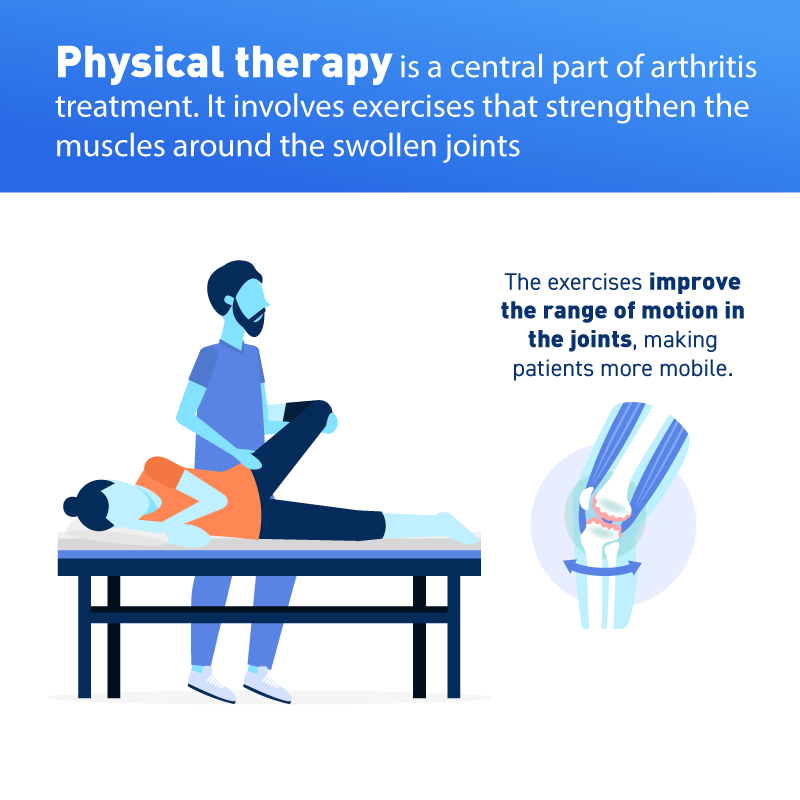
Transcutaneous Electrical Nerve Stimulation
Another form of therapy for arthritis is transcutaneous electrical nerve stimulation, also known as TENS therapy. This uses tiny pulses of electricity on the swollen joints, through electrodes that are placed on the skin above the joint. They provide temporary relief from the pain, and they can even be administered at the patient’s home.
TENS equipment is “small, portable, and relatively discrete.” Patients can carry the device in their pocket or even attach it to a belt, so they can immediately administer pain relief at any time during the day. Most sessions are no more than 15 minutes long, making this a very accessible form of treatment.
TENS can also reduce joint deformity and protect the functions of joints that are affected by arthritis.
Pregnant women and patients with epilepsy, heart problems, or other electrical or metal implants (like pacemakers) should not use TENS devices.
Additionally, there has not been a significant amount of research and testing done on TENS, so there is not yet a consensus on whether it could be a standard treatment for arthritis. However, it remains popular because it is a noninvasive and low-risk option for many people who want relief from their joint pain.
Diathermy Therapy
Similarly, there is diathermy. This is a form of therapy where a high-frequency electric current stimulates heat generation within body tissues, assisting with an increase in blood flow and pain relief for swollen joints. It can also improve the mobility of joint tissues as they heal. The current can penetrate up to two inches beneath the skin’s surface.
The equipment does not apply heat directly to the body. Instead, the heat comes from within the body, as a response to the waves generated by the machinery.
Diathermy is not a treatment mechanism in and of itself. It should always be used as part of a bigger treatment plan, including medication and physical therapy.
The increase of blood flow as a result of diathermy can make stricken connective tissues much more flexible, minimizing inflammation and decreasing the chances that fluid retention (edema) will develop.
Like transcutaneous electrical nerve stimulation, diathermy is still an experimental therapy, and is not considered to be a truly effective treatment. As a result, it should only be used in conjunction with more established arthritis treatments.
Risks and Precautions for Diathermic Therapy
Diathermy uses shortwave and microwave radiation, so people who have metal sutures, bone pins, and dental fillings can experience extreme heat through diathermic equipment, even if those implants are nowhere near the site of administration. The risks are such that the burns might cause tissue damage, so patients who have these implants (including various intrauterine devices and prostheses) would not be candidates for diathermic therapy.
Because of how diathermy works, patients become a part of the electrical field of the machinery, so touching a bare metal object (like the metal part of the diathermy equipment) could cause an electric shock or a burn. The Physiotherapy journal noted this as one of the “hazards” of using diathermic therapy.
Certain medical conditions, like bleeding disorders, cancer, and severe heart, liver, or kidney conditions, will also disqualify an arthritis patient from receiving diathermy treatments.
Massage Therapy for Arthritis
Lastly, there is massage therapy. This is still considered a form of complementary and alternative medicine, but there is a lot of evidence to suggest that massages have a role to play in the treatment of arthritis, along with medication and physical therapy. In 2017, for example, the Pain Medicine journal wrote that patients who received 10 massage therapy sessions experienced improvements in their chronic low-back pain.
Similarly, other studies have found that massages can “relieve pain and increase range of motion” in patients who suffer from neck arthritis, and massage therapy proved useful for patients who have knee osteoarthritis. The PLoS One journal went so far as to say that the “optimal treatment for relief is a weekly 60-minute [massage] session,” and that this should be a standard for further research into arthritis treatments.
In writing why massages should be a regular part of weekly arthritis treatments, Healthline explains that this is a “safe, natural way” to induce the muscles to relax and to stimulate greater movements in the inflamed joints. Therapeutic massages compress the soft tissue and prompt them to increase blood flow. This, in turn, loosens the tension in the tissues, bringing about mobility and range of motion.
On a related note, yoga exercises for arthritis relief also exist, as a form of “working through the pain.” Yoga has many documented physical and mental health benefits, but it should always be practiced with great caution.
Yoga is a better option for patients who still have some range of motion in their impacted joints. Patients with advanced or chronic arthritis could exacerbate their condition if they attempt yoga, but massages and medication could get them to a point where light physical therapy becomes the next step of their treatment.
References
Arthritis. (August 2017). Healthline.
Diagnosing Juvenile Arthritis. (May 2019). WebMD.
Role of Body Weight in Arthritis. Johns Hopkins Arthritis Center.
16 Early Symptoms and Signs of Rheumatoid Arthritis. (June 2019). MedicineNet.
Arthritis-Related Statistics. (July 2018). Centers for Disease Control and Prevention.
Arthritis. (March 2018). Mayo Clinic.
Osteoarthritis and Wear and Tear of Joint Cartilage. (December 2018). Verywell Health.
HLA-DR4 and Other Genetic Markers in Rheumatoid Arthritis. (1988). British Journal of Rheumatology.
Heat and Cold Therapy for Arthritis Pain. (November 2017). WebMD.
Use of NSAIDs in Treating Patients With Arthritis. (2013). Arthritis Research and Therapy.
Use of Capsaicin Cream. (September 2018). Healthline.
What Are the Causes and Types of Arthritis? (November 2017). MedicalNewsToday.
What Is Joint Fusion Surgery? (March 2017). WebMD.
Physical Therapies for Arthritis Pain. (September 2009). Everyday Health.
Physical and Occupational Therapy for Arthritis. (April 2019). WebMD.
9 Worst Jobs for Your Joints. Everyday Health.
What Is a TENS Unit and How Does It Work? (November 2018). Medical News Today.
Transcutaneous Electrical Nerve Stimulation (TENS) for the Treatment of Rheumatoid Arthritis in the Hand. (2003). The Cochrane Database of Systemic Reviews.
Diathermy. (January 2017). Healthline.
On the Safe Use of Microwave and Shortwave Diathermy Units. (1987). The Australian Journal of Physiotherapy.
Electromagnetic Fields From Therapeutic Diathermy Equipment: A Review of Hazards and Precautions. (January 1991). Physiotherapy.
Real-World Massage Therapy Produces Meaningful Effectiveness Signal for Primary Care Patients with Chronic Low Back Pain: Results of a Repeated Measures Cohort Study. (July 2017). Pain Medicine.
Neck Arthritis Pain Is Reduced And Range of Motion Is Increased by Massage Therapy. (November 2014). Complementary Therapies in Clinical Practice.
Massage Therapy for Osteoarthritis of the Knee: A Randomized Controlled Trial. (December 2006). Archives of Internal Medicine.
Massage Therapy for Osteoarthritis of the Knee: A Randomized Dose-Finding Trial. (2012). PLoS One.
Here’s Why You Should Add a Weekly Massage to Your Existing Arthritis Treatment. (January 2019). Healthline.
9 Yoga Poses for Arthritis Relief. Everyday Health.
The Physical Benefits of Yoga. Harvard Health Publishing.

